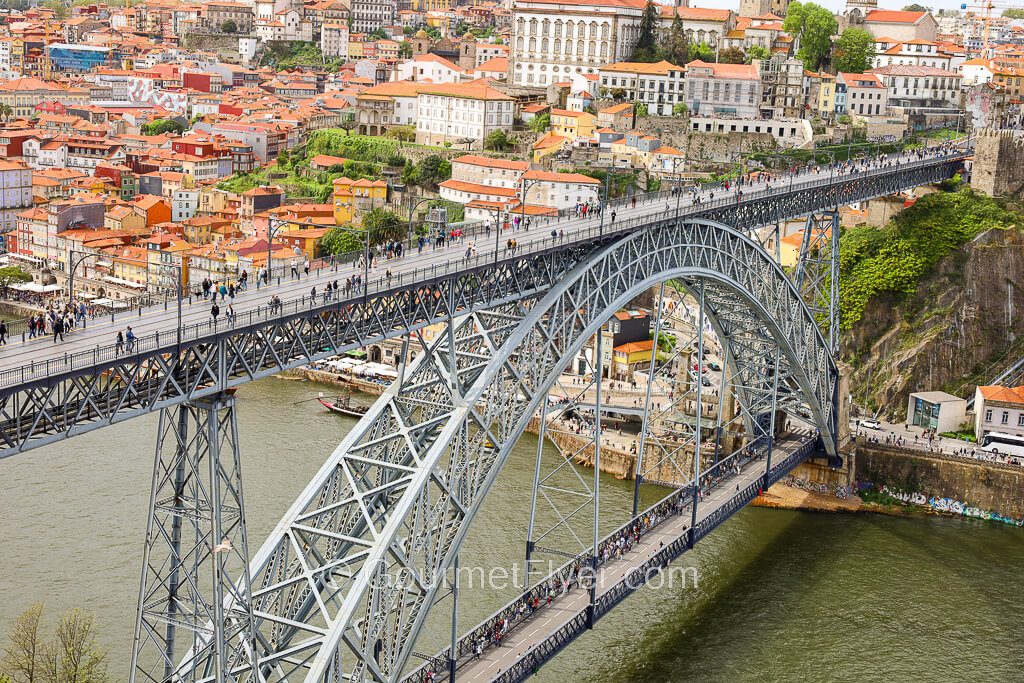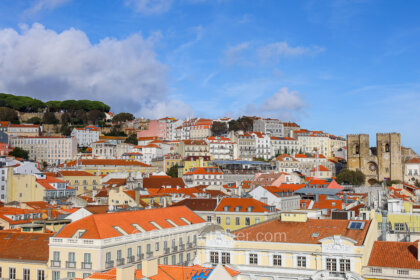This is a self-guided one-day in Porto itinerary that is designed for those who have limited time and would like to hit all the major highlights of the city in a day and to squeeze in a trip across the Douro River to Gaia as well.
For those staying here multiple days, this is a great guide for you as well, as you can still set aside one day to do this walking tour. If this is the case, I recommend you do this on the first day of your visit so that you’ll get a good orientation of the city as well as all the major points of interest. You can then spend more time in your subsequent days to explore the places that interest you most in a more leisurely fashion.
Table of Contents
- Overview
- Sé do Porto/Museu do Vitral
- São Bento Railway Station
- Igreja e Torre dos Clérigos
- Rua das Flores
- Cais da Ribeira (Ribeira Waterfront)
- Six Bridges River Cruise
- Dom Luis, I Bridge Lower Level
- Cais de Gaia (Gaia Riverside)
- Cable Car
- Jardim do Morro/ Mosteiro da Serra do Pilar
- Dom Luis, I Bridge Upper Level
- Conclusion
Overview
For the most direct and linear walking path, we will start the one day in Porto tour at the iconic cathedral and work our way to São Bento Station, followed by the Clérigos Tower. However, please feel free to rearrange the order of the first three attractions based on where you are staying or where you are coming from to make the journey most efficient for you.
Our next stop is the famous and lively Rua das Flores where I’ll introduce you to some delicious local food. We’ll continue walking until we reach the waterfront where you can break for lunch if you choose to. If not, there are plenty of opportunities to savor some delicious local foods along the way.
One of the highlights of your visit is the Douro River cruise, so be sure not to miss it. After the excursion we’ll walk across the lower level of the Dom Luis I Bridge to explore the many attractions in Gaia. When your legs are just about ready to give up, we’ll break for afternoon tea and then take the cable car to Jardim do Morro (so you don’t have to climb all the way back up). After we explore some breathtaking viewpoints, we’ll walk across the upper deck of the bridge – alongside the train – back to the city center.
Sounds good? Then let’s go!
Sé do Porto/Museu do Vitral
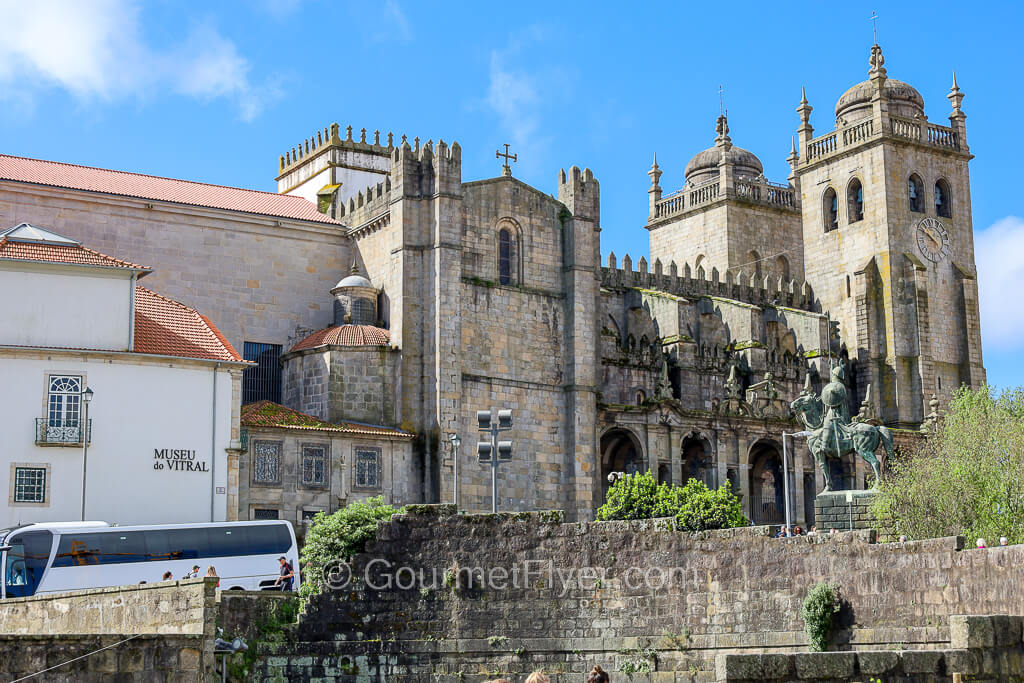
The Porto Cathedral (directions) is a national monument and is also the most important Roman Catholic church in the city. It is a major landmark of Romanesque architecture. However, during subsequent constructions and renovations in the 14th – 16th centuries, baroque and gothic styles were blended into the design of the interior. Its façade still remains mostly Romanesque. One unique characteristic of the church is its fortress-like appearance, which is due to the fact that it was part of the original construction of the city walls.
One of the most significant events that was held in the cathedral was the Royal marriage between King D. João I and Princess Filipa. A mural depicting the scene of the wedding can be found on the walls of the São Bento Train Station (see the section below).
The Museu do Vitral or stained-glass museum is located next to the Sé and is truly a hidden gem that is often overlooked by tourists.
The museum is dedicated to the stunning works of glass art, which features a kaleidoscope of stained glasses in all colors, forms, and shapes. Stained glass has a rich tradition and history, and is often regarded as one of the most significant expressions of religious symbolism. You will learn about its unique production methods, which include a painting process that allows the passage of light. It is indeed an eye-opening and enriching experience.
Admission as of this writing is €8 which includes a glass of port wine (adults only).
São Bento Railway Station
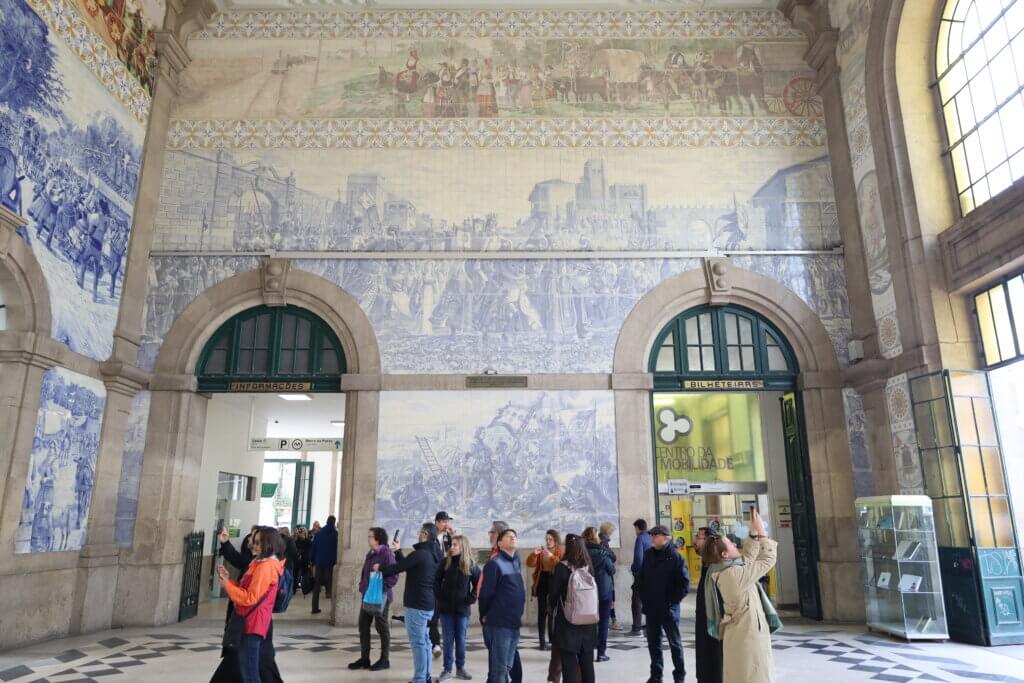

This is one of the very few trains stations in the World where most of the people who go there are not there to board a train. Most visitors go there to appreciate and admire what is often referred to as the most beautiful train station in the World.
Its interior is graced with large panels of art made with over 20,000 pieces of azulejo – the iconic Portuguese tile with a distinctive bluish color and typically painted meticulously with arts. The creator of these amazing murals in São Bento Station, Jorge Colaço (1868-1942), was originally a canvas painter who studied in Paris. He experimented using tiles as canvas for his paintings, and eventually became one of the most renowned Portuguese azulejo painters.
Many of the murals depicts scenes that represent defining moments in the country’s history. For example, the picture (above right) portrays Prince Henry the Navigator conquering the Port of Ceuta. Other significant moments include the royal wedding of King D. João I in 1387. Some murals also portray rural life as well as many other cultural aspects of the country.
Igreja e Torre dos Clérigos

The Clérigos Tower (directions) is attached to a church which is an 18th century baroque masterpiece with stunning architecture. The 250-foot-tall Torre dos Clérigos is an iconic structure in Porto’s historical center, and you can see it distinctly protruding above the city’s landscape, as shown in the picture above. The tower offers a panoramic view of historical old town, the Douro River, and parts of Gaia. To reach the top, you’ll have to climb up a spiral staircase of 225 steps, but I assure you that the view is certainly worth the workout.
Admission to the church is free, but tickets to the tower and museum cost €8 as of this writing.
Rua das Flores
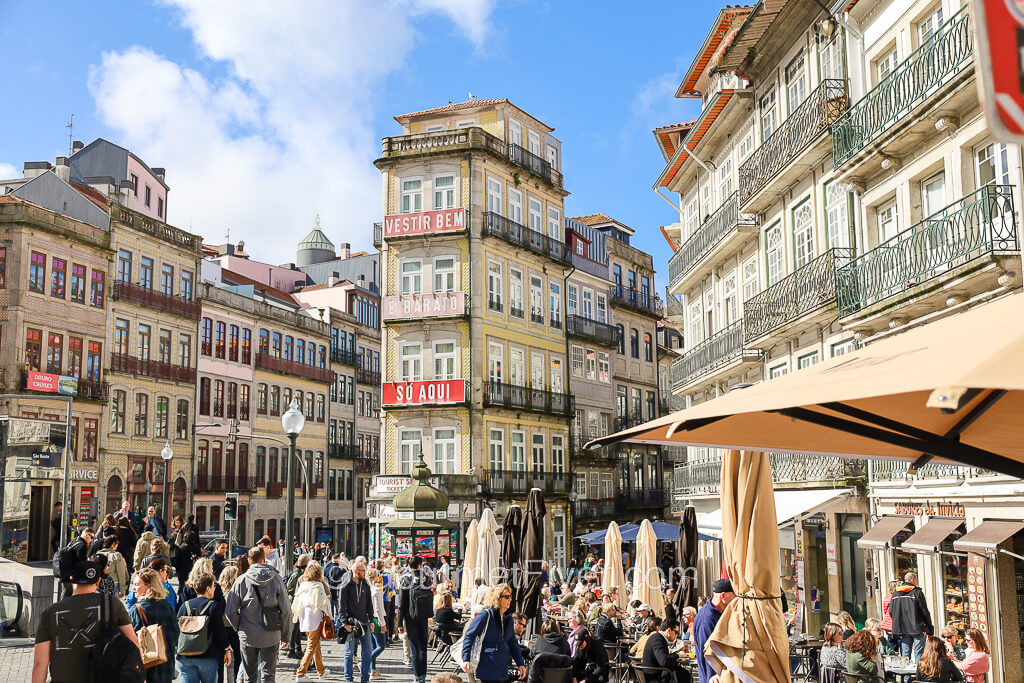
Our one day in Porto itinerary includes a stroll down this famous and vibrant shopping and dining pedestrian street. Depending on the season that you visit, Rua das Flores could be very crowded, but still take a moment to soak in the local scenery, be amazed by buildings with Portugal’s traditional façades, and explore the many local specialty stores. Photographers will have plenty of opportunities to snap that Instagram-worthy post. Feel free to explore the maze of side streets and narrow alleys and have fun getting lost. Really! If you are truly lost, set your google map to Cais da Ribeira and it will put you back on track and guide you to the waterfront.
The lively activities start just across from São Bento Station where there are often street performers. The performers in the video above that are dressed like Harry Potter are actually college students. It is a lesser-known fact that in Portugal, college students do wear uniforms that look like Harry Potter’s cape. While uniforms are optional when attending classes, they are almost always worn when participating in extracurricular activities.

There is no shortage of cafés and pastelarias displaying dozens of goodies of all kinds. You might already be familiar with the iconic pastel de nata, a dessert tart made with a shell that is crispy, flaky, and slightly buttery. It is filled with a custard composed of egg yolk, cinnamon, and honey. The top of the custard is typically slightly burnt to bring out the flavor and aroma of its ingredients.

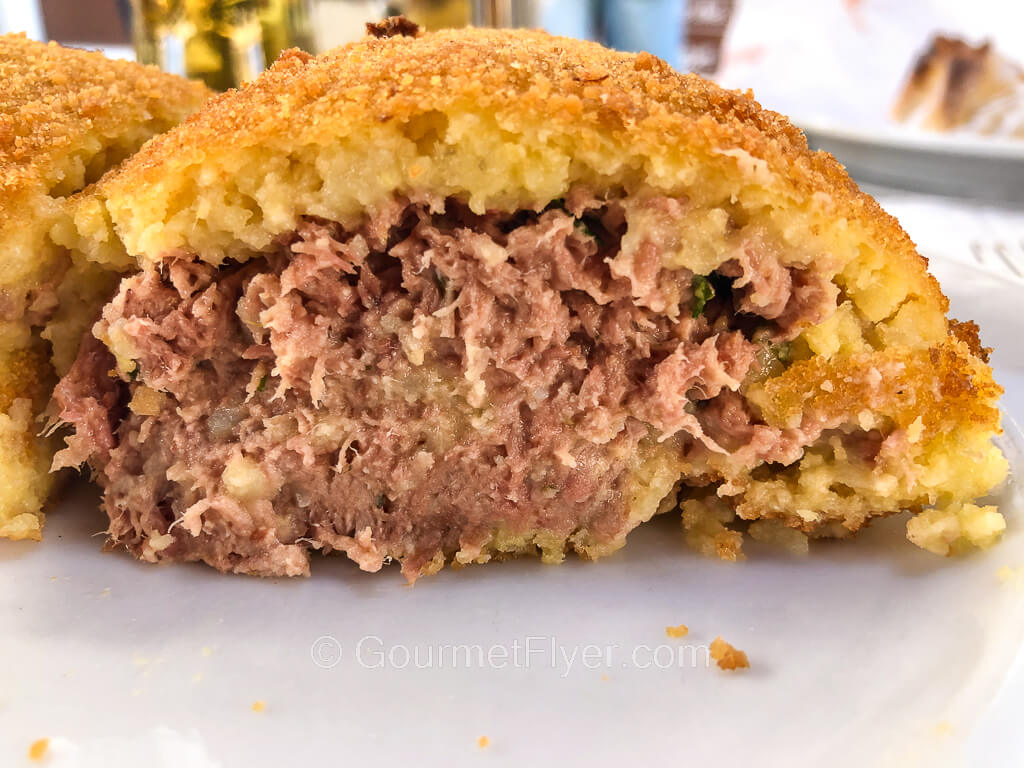
Let me also introduce you to a very popular local favorite – the pastel de salgado – a savory fried pastry somewhat like a croquette but is much larger and more filling. They are usually stuffed with fish, meat, or vegetables. I tried a mashed potato with minced meat version from a café called Sabores da Invicta (directions) and absolutely loved it. Above is a picture of the pastry and its cross-section.
As a very general guide, the budget friendly and casual eateries are closer to the part that is near the station. If you walk further down to near the end of the street, you will find restaurants that range from moderately priced to fine dining.
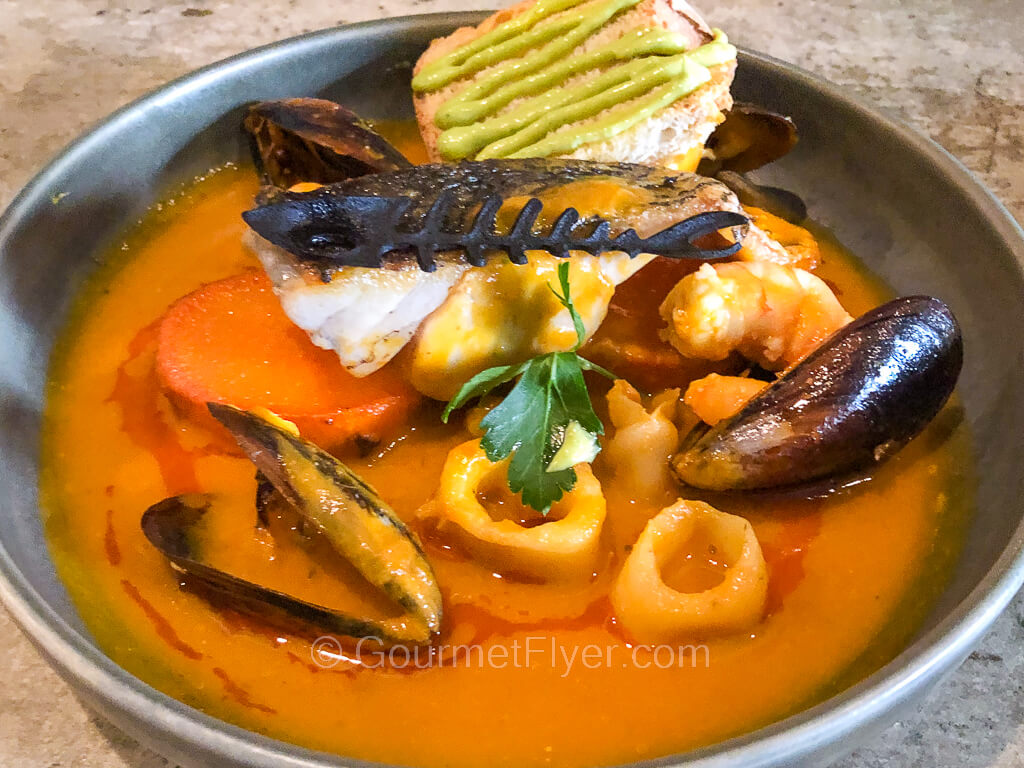
You probably already know that Portugal is famous for its fresh seafood and a fish or seafood stew (caldeirada) is a must-try local comfort food in your one-day adventure in Porto. I had this stew from a very popular restaurant called Largo São Domingos, nicknamed LSD (directions) and it was excellent. A variety of seafood and sweet potato were cooked in a rich tomato-based broth with a touch of chili oil and dill. Prices were moderate, with most entrées between €18 – 25. Portions were large, and service was attentive.
Cais da Ribeira

The Ribeira Waterfront is a vibrant area packed with all kinds of eateries, street performers, shops, and street vendors. You can find almost any local specialties such as cork products, tiles and ceramics, leather goods, jewelry, and souvenirs. Stroll around and enjoy the festive atmosphere in one of the most romantic and scenic backdrops in Europe.
A very general guideline for lunch is that the restaurants closest to the bridge are typically more expensive and are slightly upscale. The ones that are closer to the piers where you take the river cruise (as shown in the picture above) are more casual and budget friendly. Note that some of these casual restaurants accept cash only.
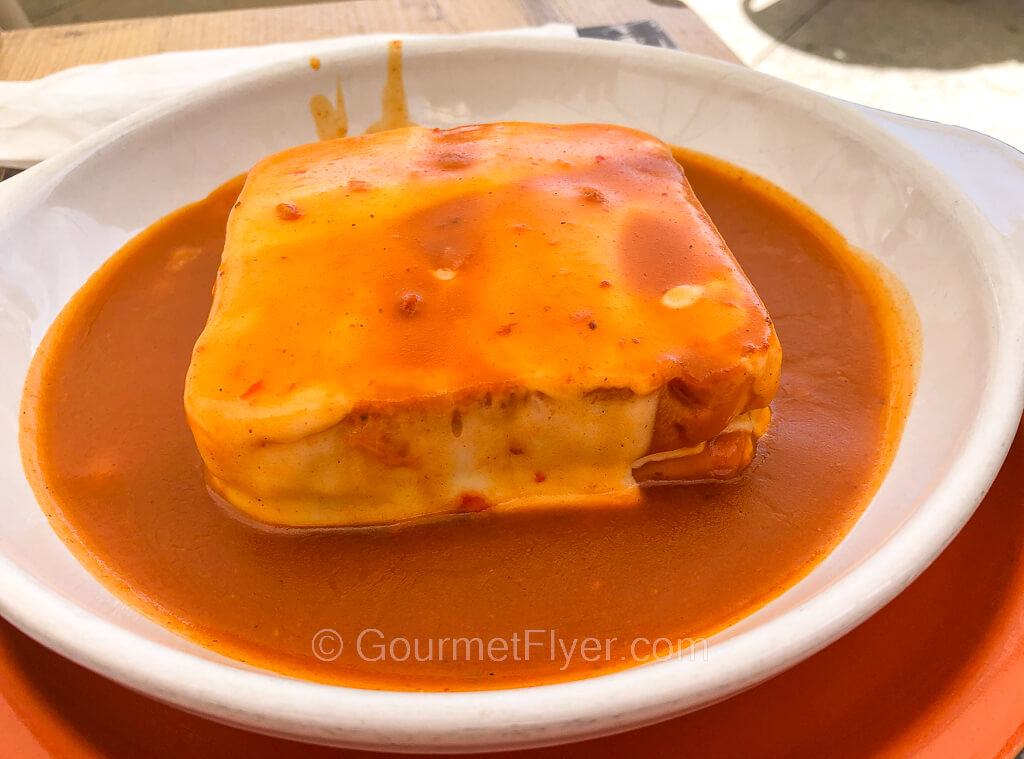
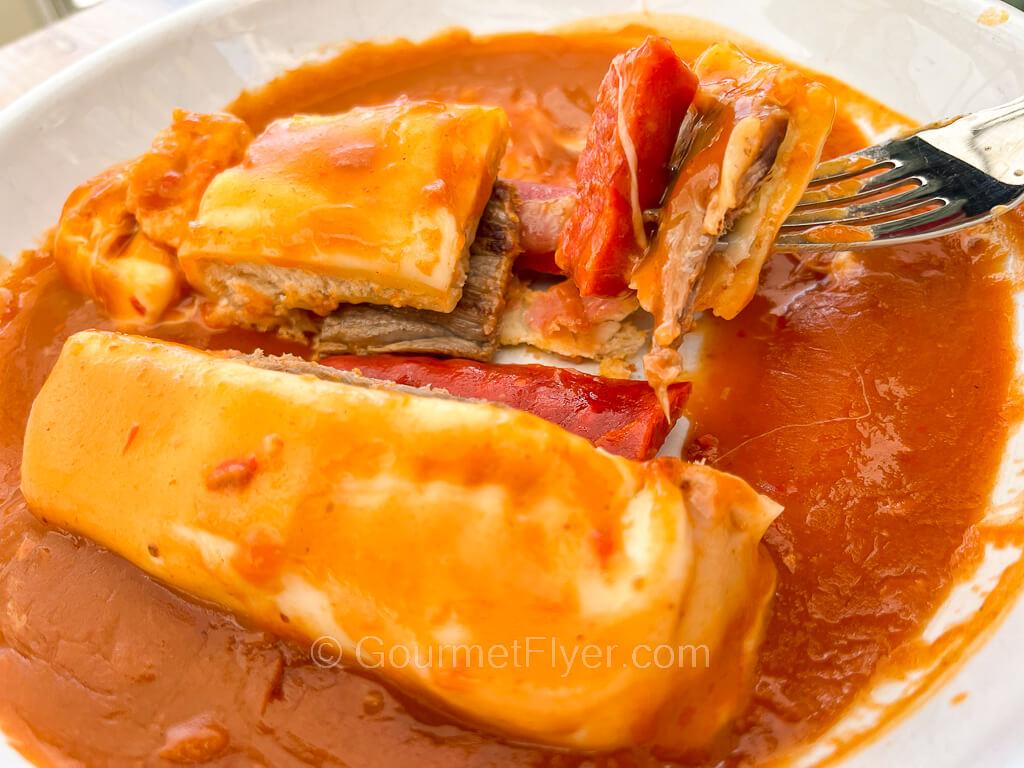
Typical casual fares include pizzas, burgers, sandwiches, and salads. What I highly recommend is that you forget about all of the above and try a local specialty. Porto is the home of the francesinha – layers of toasted bread stuffed with ham, cheese, steak, and sausage and served in a spicy tomato sauce. The pictures above show the sandwich when it was served and then cut up to display the fillings. This local special dish is available in almost every restaurant on the waterfront.
Six Bridges River Cruise
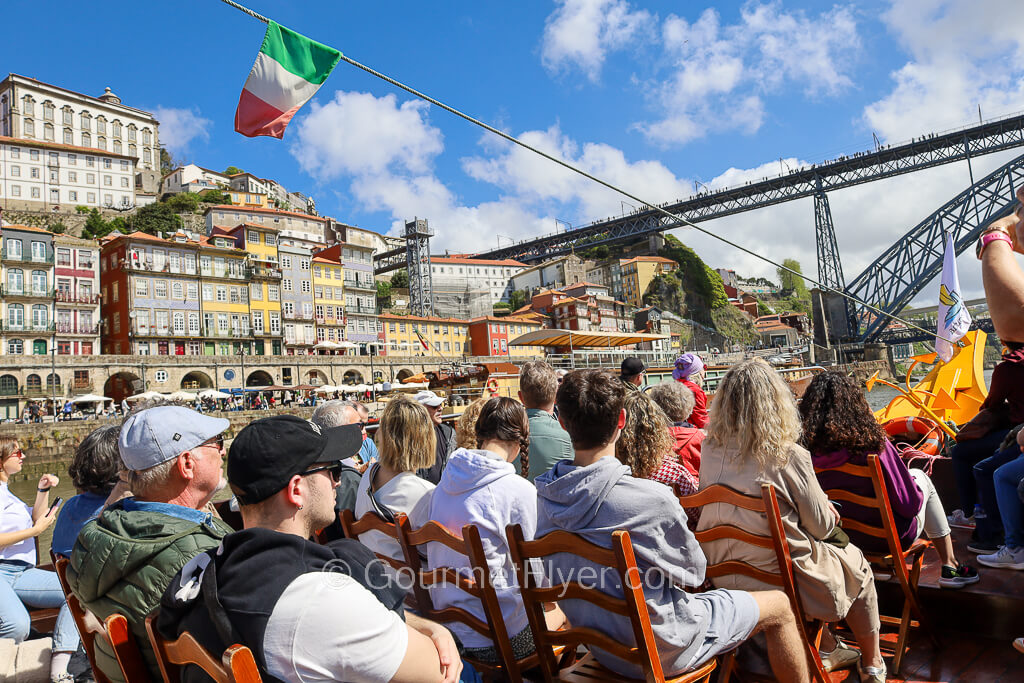
One of the major highlights to your one day in Porto itinerary is the Six Bridges Panoramic Cruise on the Douro River, which is not to be missed. As the name of the cruise implies, there are six bridges in the city. Each of them has a unique story behind it and also displays its own distinct architectural style. During the cruise, there will be recorded commentary on the background and constructions of the structures. The cruise starts by passing under the iconic double-deck Dom Luis I Bridge as shown in the picture above.
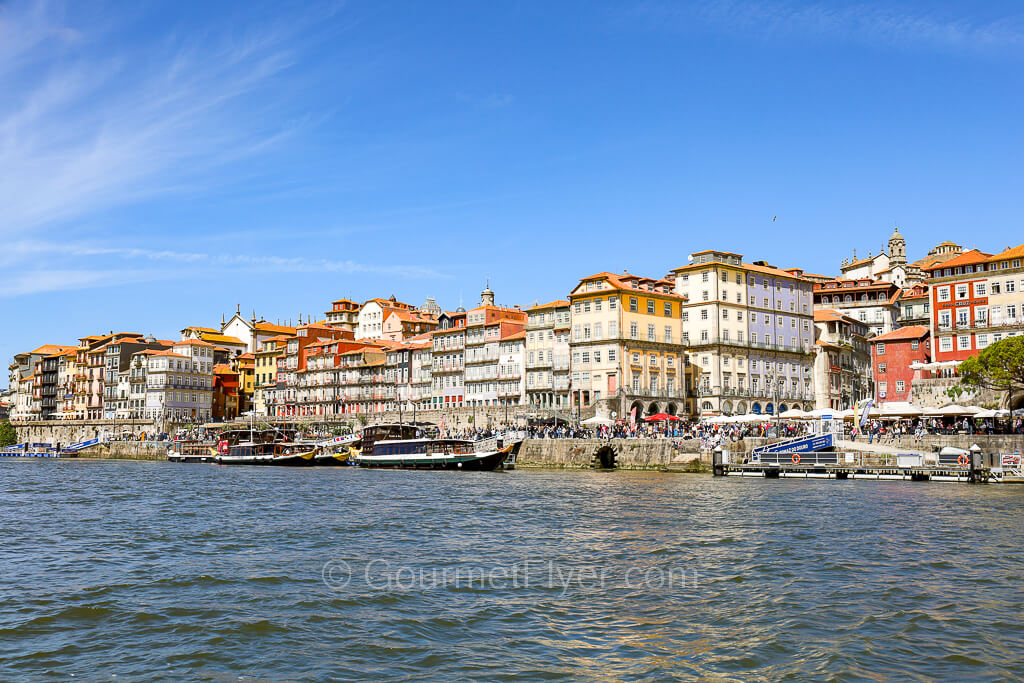
The journey continues as we pass through four more bridges – the Infante Dom Henrique, Dona Maria Pia, São João, and finally Freixo, before turning around. We then head toward the bridge on the far west of the city – Ponte da Arrabida – before turning around again. As we sail along the Douro, you can enjoy breathtaking scenery on both side of the river. Above is a picture of the Ribeira Waterfront as seen from the boat. Since the cruise turns around twice, you get the best vantage point no matter which side of the boat you are seated on.
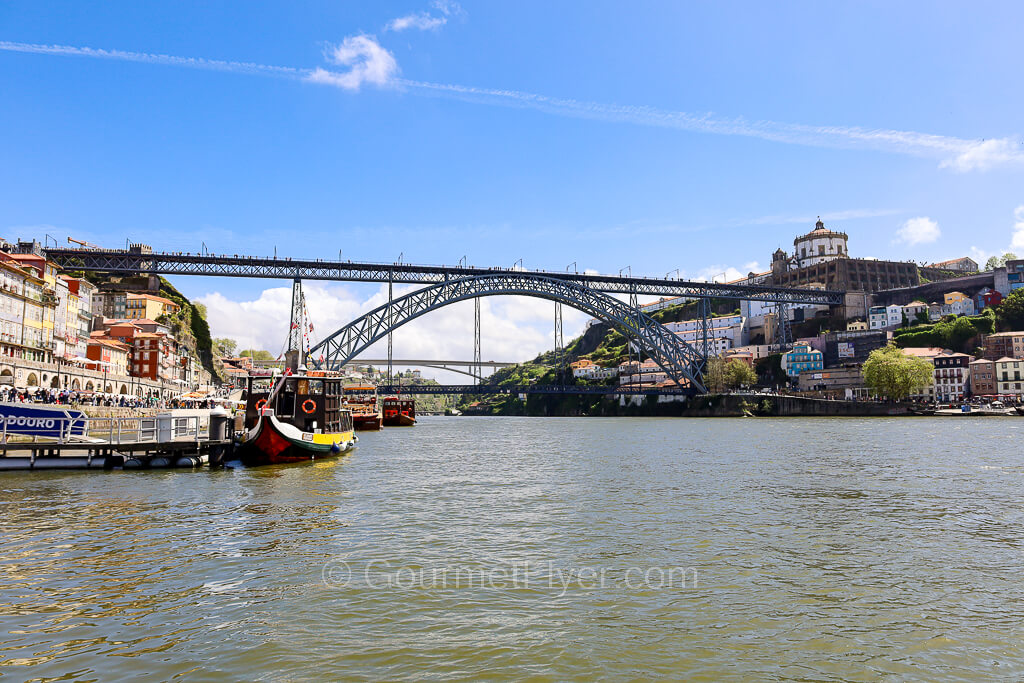
The picture above shows our final approach back to the pier. The Ribeira Waterfront is on our left, and Gaia is on our right. The round cylindrical building high above on your right is the Mosteiro da Serra do Pilar, which we will visit later in the day. Connecting the two cities is the iconic double-deck Dom Luis I Bridge which we will be walking across in just a moment.
Dom Luis, I Bridge Lower Level
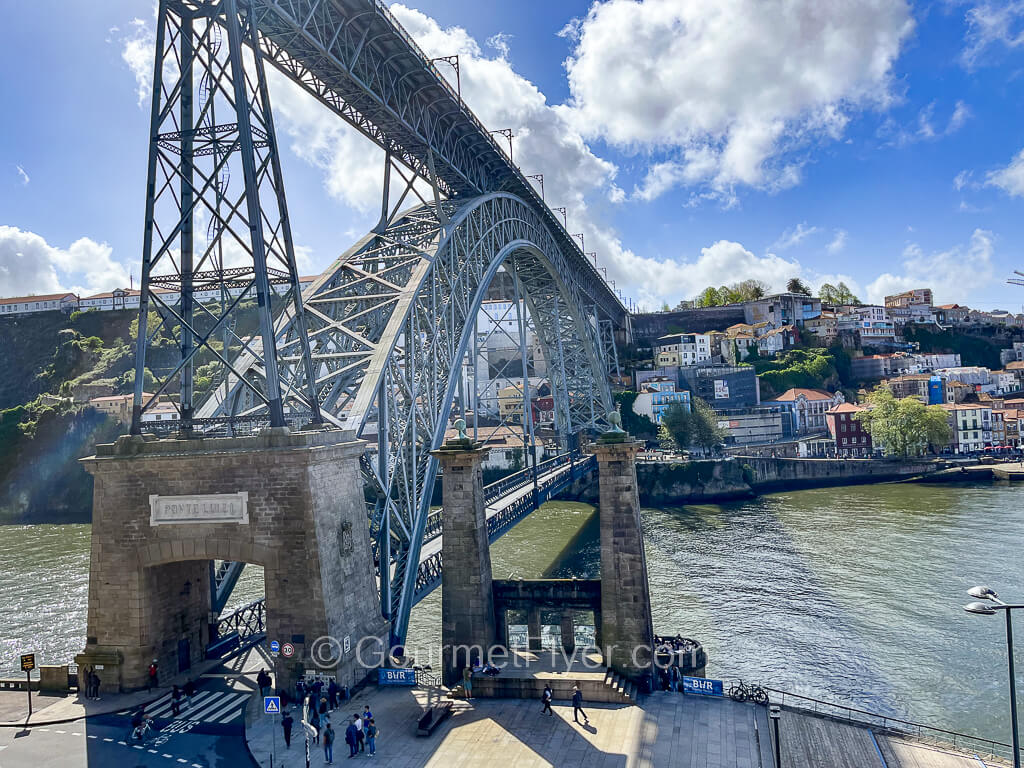
The lower deck of the passageway is shared between pedestrians and cars and takes you directly to the waterfront of Vila Nova de Gaia, which most people simply refer to as Gaia. The walking distance is 385 meters or just about a quarter of a mile. The walk is very scenic so take your time and enjoy every moment of it.
You get a different perspective of the river from high above, looking at the boats passing underneath you. When you are halfway through, you can see a distinct difference between the landscapes of the two waterfronts.
Cais de Gaia (Gaia Riverside)
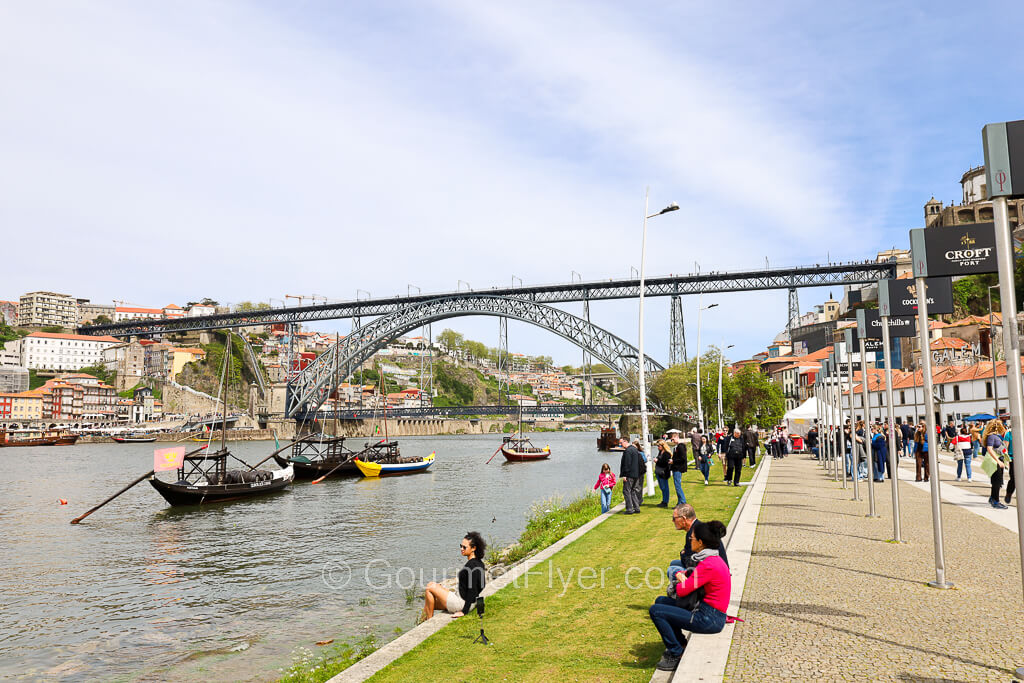
To explore the waterfront also known as Riverside, simply turn right once you cross the bridge. The path is mostly linear with a few side streets and detours along the way if you have the time (and energy) to venture a bit further. But for this one-day journey from Porto to Gaia, we will stop near the cable car station as this is typically a lot of walking already for most people. Plus, we still have yet to climb up a steep ramp to get to the Mosteiro da Serra do Pilar.

Soon you’ll find out: The best vantage point to admire the beauty of Porto is from Gaia. Take your time to soak in the romance and magic that is in the air.

If you haven’t had lunch yet, there are plenty of dining options along the vibrant promenade, many of which come with port wine pairing.
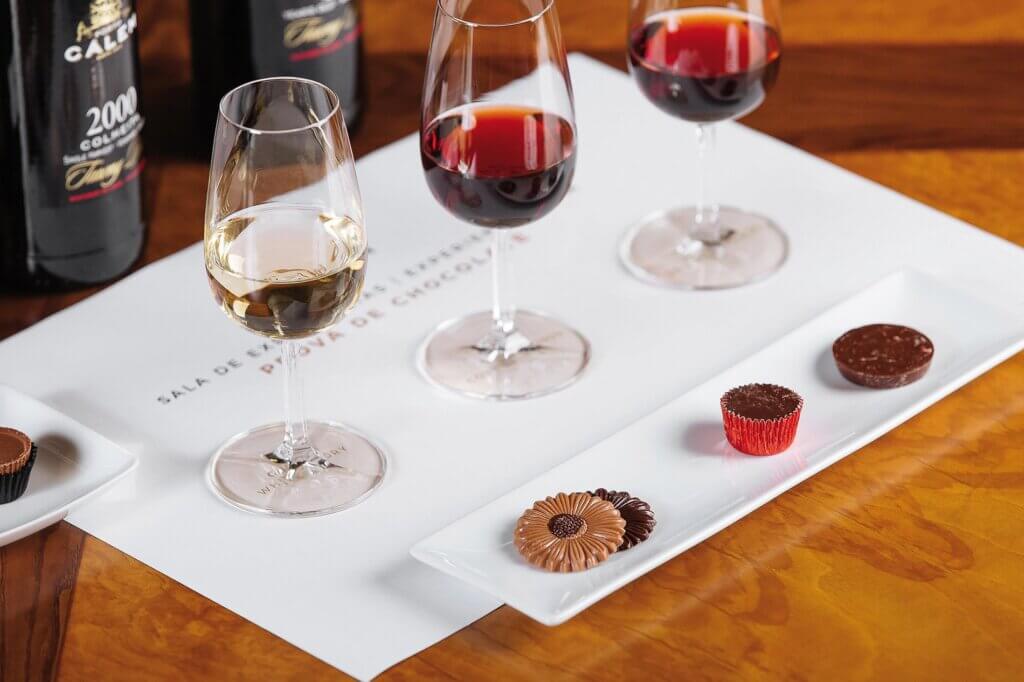
One of the most popular local flavors is indeed port wine and there are plenty of options along the Gaia Riverside – from small tasting rooms to extensive cellars with elaborate tours and shows, and everything in between.
One of the best known and most expansive facilities is Cálem Porto which is just a short walk from the bridge. Attractions there include food and wine pairing, cellar tour, and a fado show. The downside to the tour is that it has a large capacity of 45 people and lacks personal attention. Sometimes it is hard to hear if you are in the back of the pack.
Just a minute’s walk away from Cálem is Quinta do Noval. In contrast to the large operation in Cálem, Quinta is a tasting room only. But if it is the wine that matters, Quinta has been around since 1715 and is one of the most respected brands in the region.
If you continue strolling along the Riverside, there are more tasting opportunities for you to explore.
But if you are really serious about wine tasting and demand an informational, interactive, and intimate setting, then I suggest joining a Port Wine Tour covering 3 cellars with 7 tastings and a maximum capacity of 12 participants. This excursion meets right on the Gaia waterfront and is very easy to get to. Note that advanced reservations and tickets are required as the capacity limit is only 12 people.
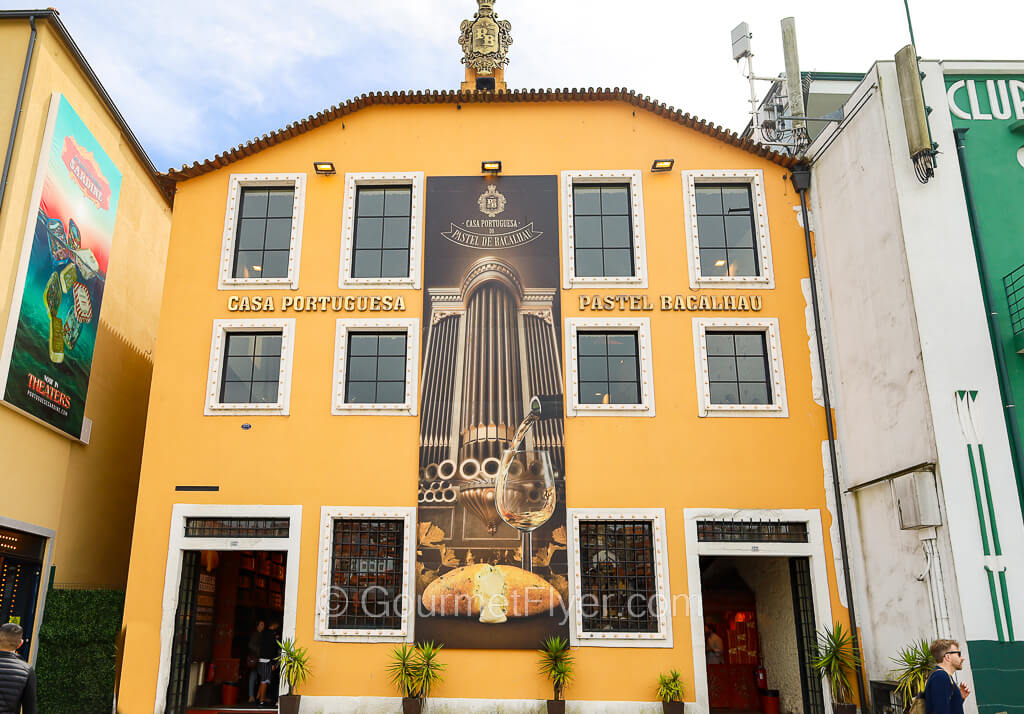
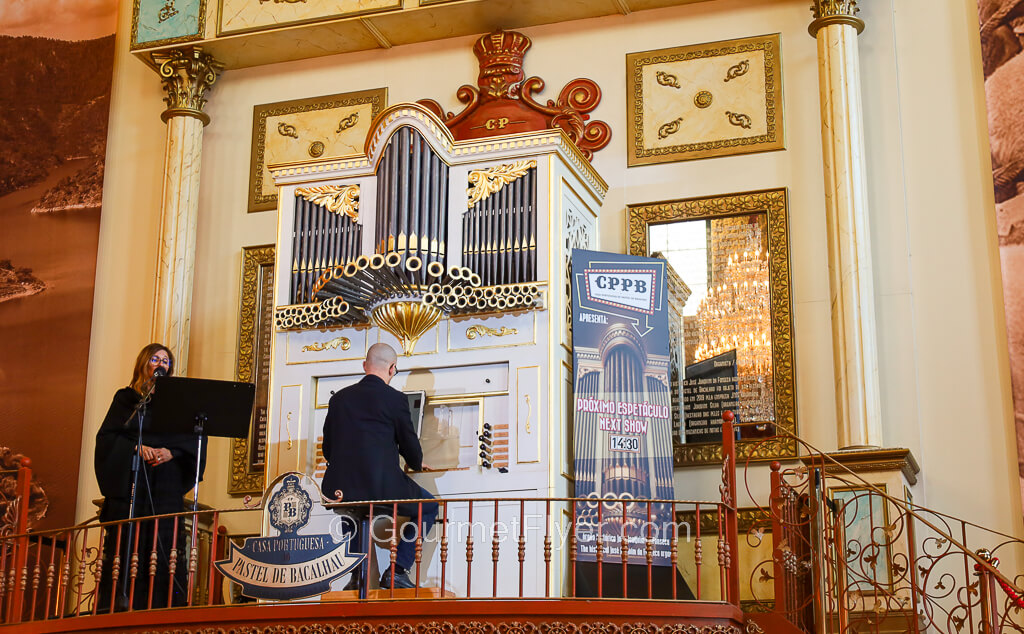
As you explore all the attractions along the Riverside, let me point out one place that you shouldn’t miss: Casa Portuguesa do Pastel de Bacalhau, or the Portuguese house of codfish pastry. The moment I walked in there the first time, I felt like I just entered a museum. As I looked around more carefully, I saw a huge room with the setting of a Medieval library, with large and tall traditional bookcases filled with books. Then an organist started playing a 19th century Portuguese pipe organ, accompanied by a female singer.
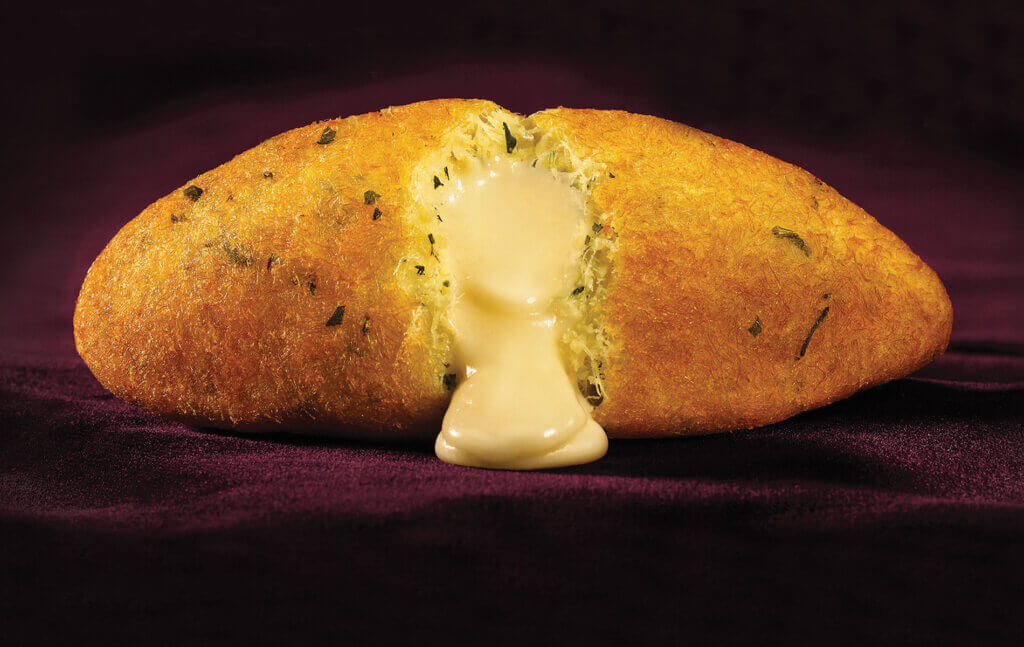
Examining the place further, I realized that it was a pastelarias selling their signature product, pastel de bacalhau. It is an oblong croquette-like fried dumpling filled with dried salted codfish, mashed potato, and melted Serra da Estrela cheese. The shell is golden brown and crispy while the filling is delicious. As with most meals in Gaia, you have the option to pair it with a glass of port wine. This is gastronomy at its best. A caveat is that you have to like fish to like this pastry. But this place is so cool that it is worth a visit even if you don’t like fish.

Let me squeeze in another stop for a snack or afternoon tea before we climb up another steep ramp to a monastery. Sancho Panza is located right next to the cable car station. They offer many variations of the classic pastel de nata with different flavors, such as lemon, orange, chocolate, and even port wine flavor.
They also specialize in a savory version of the pastel, with fillings such as chicken, beef, sardine, or codfish. I had one filled with minced beef and onion and it was delicious! Again, you can pair them up with a glass of port wine. But for me, I chose to have an iced cold Super Bock, which I think is the best Portuguese beer.
Cable Car
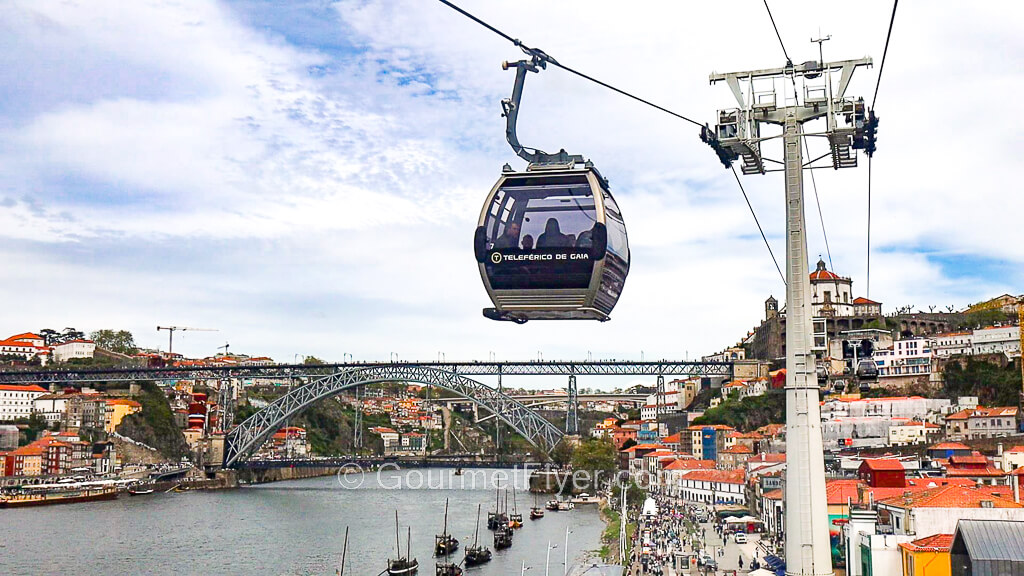
Literally next to the Sancho Panza restaurant is the cable car station. As of this writing a one-way ticket costs €7 but I assure you that the view and the experience is well worth it. Plus, it saves you from a lot of uphill walking by taking you directly to the upper deck of the bridge. The ride is short – only about five minutes – but every moment of it is scenic and enjoyable.
Jardim do Morro/ Mosteiro da Serra do Pilar
Note: Those who are not staying overnight and are pressed for time to catch a plane or a train can take the Metro from the Jardim do Morro station right here. Be sure to take it in the direction to Porto. The next stop is São Bento. After that it continues to Trindade where you can catch a Metro to the airport or connect to other Metro lines to take you to where you need to go.
For those who have the time and energy, let’s move on.


Jardim do Morro is the upper cable car station and is also a small park with scenic viewpoints. On most days in peak seasons there are plenty of vendors and street performers to entertain you. The structure that you see on the picture above is the Mosteiro da Serra do Pilar. The monastery is now permanently closed but you can still go up to the outside courtyard which provides one of the best views of the Douro River and the landscape of Porto. To go there, you need to go across the street from the garden, turn right, and keep going until you see a sign that points you to a very steep ramp up the hill.

You might have seen a lot of pictures on the Internet and on Instagram of the Luis I Bridge taken from high above, showing the upper deck and the train clearly, and wonder where those pictures are taken from. Let me let you in on a secret, many of those pictures are taken right here.
Dom Luis, I Bridge Upper Level
Walking on the upper deck of the bridge is a unique and interesting experience. Pedestrians share the road with the Metro train which comes by every ten minutes or so, depending on the time of the day. It’s funny that some people just walk in the middle of the road anyway, totally oblivious to the fact that they are walking on a railroad track. Then they become shocked when a train comes their way. I often admire the patience of the Metro train drivers that they have to slow down and sometimes stop for these pedestrians dozens of times a day, every day of the year.
So, please be considerate, and walk on the sidewalks. This is for your safety too!
Conclusion
Once you’ve crossed the bridge you are just a few minutes away from the city center. In fact, as you walk downhill, you’ll pass by the cathedral, our very first attraction of today’s one day in Porto itinerary. From there, it is about a five-minute walk back to São Bento station.
The walking tour from Porto to Gaia presented here is a picturesque and generally easy stroll which most people with a moderate level of fitness can enjoy. Along the way you’ll experience two vibrant waterfronts connected by an iconic bridge. Your trip will be punctuated by delicious local cuisines, plenty of custard tarts and pastries of all kinds, and a tasting of the famous port wine of the city. I hope this travel guide will inspire you to embark on this magical journey and open the doors to many more exciting adventures in the future.
